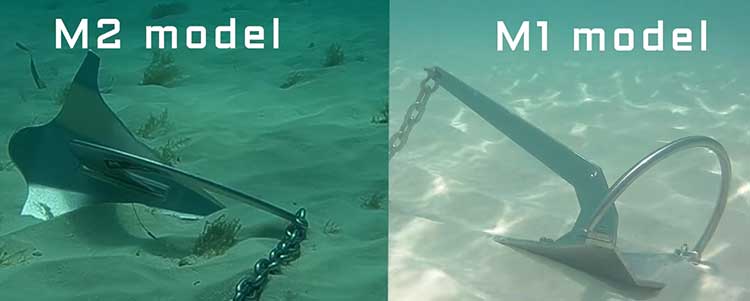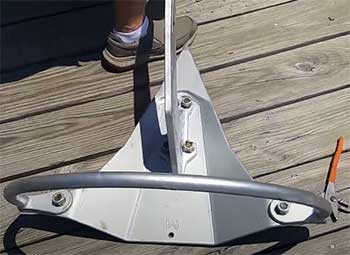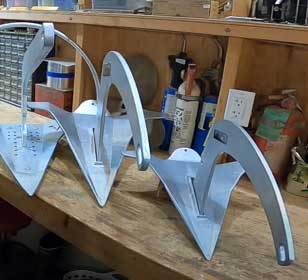Anchoring your boat or yacht is an integral part of your maritime journey. Choosing the right anchor makes all the difference when it comes to safety and convenience on the water.
Today, we’ll be diving into a detailed comparison between two popular anchors from Mantus, the M1 and M2. Both are impressive contenders in their own right, but how do they stack up against each other?
A Brief Comparison Table
| Feature | Mantus M1 | Mantus M2 |
| Design | Roll-bar | No-roll-bar |
| Setting Ability | Fast and reliable in predictable seabed conditions | Excellent in varied seabed conditions |
| Storage | Easy to disassemble and store | Easy to disassemble and store |
| Ideal Use-Cases | Best for predictable seabed conditions and sailors who value convenience | Best for varied seabed conditions and sailors who face unpredictable anchoring situations |
| Weight | Generally lighter | Slightly heavier due to more complex design |
| Versatility | Excellent for a range of common seabed types | Superior versatility on various seabed types |
Overview of Mantus M1 and M2 Anchors

Firstly, let’s get familiar with the basic features that these anchors offer. The Mantus M1 and M2 anchors, both manufactured by the reputable Mantus Marine company, are celebrated for their high-quality design, durability, and impressive holding power.
The M1 anchor is known for its solid steel construction and distinctive, rugged design. With its disassemblable structure, it’s ideal for boat owners who require easy storage and transportation.
The anchor is also famed for its exceptional setting ability and high resistance to wind and tide changes.
On the other hand, the M2 anchor is an upgraded version of the M1. It boasts similar high-grade steel construction, quick setting ability, and robust holding power, but with a twist.
The M2 is designed for more challenging seabed conditions, making it the anchor of choice for those facing varying sea bottoms or unpredictable weather.
- Advantages of Mantus M1 Anchor
The M1 anchor shines in many aspects, but its main selling point is its uncompromising setting ability. Thanks to its roll-bar and sharp, pointed edges, it penetrates the seabed swiftly and sets up in mere seconds.

This means a less stressful anchoring experience and increased safety in calm or rough waters alike.
Another notable advantage of the M1 is its disassemblable design.
It breaks down into smaller components, which can be packed and stored effortlessly.
This makes the M1 particularly attractive for sailors who may be limited on space or often move their anchoring equipment.
Finally, the M1’s robust, solid steel construction ensures its durability and longevity. You can expect the M1 to serve you faithfully, whether you’re an occasional boater or a seasoned sailor.
- Advantages of Mantus M2 Anchor
As a successor to the M1, the M2 naturally carries over the advantages of its predecessor. It has a similar setting ability, dismantlable design, and solid steel construction. But the M2 takes things a step further.
The standout feature of the M2 is its versatility. Designed to operate on various seabed conditions, this anchor is perfect for those facing unpredictable sea bottoms, from sandy to rocky, or muddy.
The anchor’s flukes are optimized for superior seabed engagement, providing excellent holding power irrespective of the seabed type.
Moreover, the M2 is equipped with a no-roll-bar design. This feature allows the anchor to set correctly even when landing on the seabed upside down. It’s an added layer of convenience and reliability that every sailor appreciates.
- The Cons of Mantus M1 and M2 Anchors
No product is perfect, and these anchors are no exception. The M1, while impressive, may struggle a bit in mixed and rockier seabeds. The roll-bar design, although ensuring fast setting, can sometimes be an issue when the anchor lands upside down.
For the M2, its versatile seabed performance and no-roll-bar design come at a cost. This anchor is slightly heavier than the M1, which might make handling and transporting it a bit more challenging.
Key Differences Between Mantus M1 and M2 Anchors
While both the Mantus M1 and M2 anchors are standout products in their category, they offer distinctive features that make them uniquely suited for different scenarios.
In this section, we will delve deeper into the major differences between these two anchors, covering aspects such as their design, performance, and ideal use-cases.
- Design

The design of an anchor is critical to its performance.
While the Mantus M1 and M2 share similar steel construction and the ability to disassemble for convenient storage, there are some key differences to note.
The M1 is built around a roll-bar design.
This feature allows the anchor to position itself correctly, ensuring a quick set on the seabed.
However, in certain circumstances, the roll-bar can be a drawback, especially when the anchor lands upside down.
On the contrary, the M2 comes with a no-roll-bar design. This design allows the anchor to set correctly even when it lands upside down on the seabed. This is an essential feature for sailors facing unpredictable anchoring conditions.
- Performance
Both the M1 and M2 are highly capable performers. However, their performances shine in slightly different contexts.
The M1 is known for its impressive setting ability. Its design allows it to penetrate the seabed swiftly, ensuring fast and secure anchoring. This makes the M1 an excellent choice for boaters sailing in predictable seabed conditions.
The M2, while carrying over the M1’s swift setting ability, offers more versatility. Its flukes are designed to ensure excellent seabed engagement, whether the bottom is sandy, rocky, or muddy. This makes the M2 ideal for sailors who often face varied seabed conditions.
- Ideal Use-Cases
Given their design and performance differences, the M1 and M2 anchors are more suitable for different scenarios.
The M1’s quick setting ability and ease of storage make it a great choice for those who prioritize speed and convenience. It’s especially useful for sailors who often sail in relatively predictable seabed conditions and value the ability to stow their anchor quickly and efficiently.
On the other hand, the M2’s versatility makes it the go-to choice for those who frequently encounter varied seabed types. Its ability to set correctly, irrespective of how it lands on the seabed, provides an added layer of reliability in unpredictable anchoring conditions.
Also Read: Comparison of Minn Kota Raptor And Power Pole.
Final Verdict
Both the Mantus M1 and M2 anchors are formidable options for any boater. If you prioritize easy handling, compact storage, and quick setting, the M1 would be your anchor of choice.
However, if you often sail in varying seabed conditions and need an anchor that adapts to the environment, the M2 could be the one for you.
Remember, choosing between the Mantus M1 and M2 anchors ultimately comes down to your specific needs and circumstances. Consider your sailing environment, your storage capacity, and your personal preferences before making a decision. Safe sailing!
Do note that both Mantus M1 and M2 anchors are just tools, and the safety on the water also heavily depends on the sailors’ skills and judgment. Thus, always practice safe and responsible boating habits, irrespective of the anchor you use.

